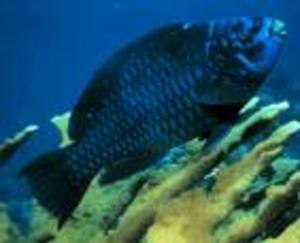Anyone familiar with the Walt Disney movie “Finding Nemo” would recognize a Blue Tang immediately. The adorable character named ‘Dory’ voiced by actor Ellen Degeneres is a Blue Tang.
This fish is also known as the Royal Blue Tang, Blue surgeon fish, Palette Surgeon fish, Hippo Tang, and the Pacific Blue Tang. It can be found in warm clear waters of the Western Atlantic Ocean near coral reefs. The range of this fish extends from the northeastern shores of the U.S. through Bermuda and the Gulf of Mexico and has been found as far south as Brazil as well as the Caribbean Sea.It is a favorite for scuba-divers and snorkelers because it is easily identifiable and beautiful to watch in its natural habitat. The Blue Tang can be found at depths of five to 120 feet. It is not generally considered a commercial fish so is usually not fished on a large scale basis. It is also not considered a game fish so most anglers and spear fishermen do not pursue them. The flesh of this fish tastes bad and some consider it toxic though it has been used for bait due to its strong odor.
Paracanthurus Hepatis is very popular in salt water aquariums. It can be identified by its vivid colors and characteristic shape. Blue Tang are usually between 8 and 12 inches long with a short compressed pancake-like ovoid body. Its eyes are round and sit up high on the head. It has a small mouth located low on the body. Adults range in color from light purple to deep blue and are distinguished by a bright yellow spine, called a caudal spine, which lies horizontally near a fan-shaped tail. This caudal spine resembles a scalpel, hence the surgeon fish moniker.
Younger Tang have the same shape as adults but usually have a bright yellow body with blue tinged fins and bluish colored peri-orbital circles. As they mature their small scales turn blue and they can sport black or dark purple markings or stripes starting at their eyes and extending across the dorsal fin to the tail which will have dark edges contrasting with a yellow colored middle. Some believe that the Blue Tang can change color depending upon its mood but this remains debatable.
The Blue Tang is described as a peaceful fish that gets along well in groups but usually live singly or in small groups.They eat mainly algae during the day and hide from predators in caves and crevices at night. Tuna and Groupers tend to be the fish that feed on the Blue Tang. They are beautiful fish and a real treat to watch as they swim gracefully through the water. But woe to the unsuspecting person who tries to handle the Tang without caution for the sharp caudal fins can inflict serious lacerations which can become infected if not cared for properly. It is not an aggressive fish and this is only a defensive reflex to predators.
Due to its algae diet the Blue Tang is considered an important species for control of overgrowth of algae. This helps prevent suffocation of coral reefs which many scientists consider an important ecological benefit.
The next time you watch “Finding Nemo” you will be able to identify ‘Dory’ as the wonderful Blue Tang.




